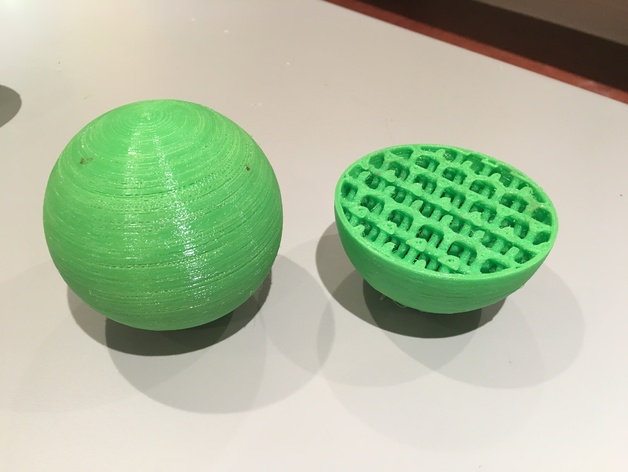
NinjaFlex Bouncy Balls with Internal Lattice
thingiverse
When I finally got NinjaFlex working on my 3D printer, my first objective was to create a bouncy ball that lived up to its name. I was initially disappointed when the 2D infill provided by my slicer resulted in a ball that bounced erratically and inconsistently, with unpredictable heights and trajectories. By applying Maker Muse's method for creating even, 3D infill, I successfully engineered a more consistent bouncy ball. Video: https://youtu.be/JWwllOorjUw Here is a breakdown of the different versions I created and how they differed: Version 0: This was my first attempt at making a NinjaFlex bouncy ball. It was simply a plain sphere with no special features, which made it bounce poorly and inconsistently. On average, it bounced anywhere from 1' 10" to 2' 8". Version 1: In this version, I used a 3D cubic lattice pattern in an attempt to improve the ball's bounciness. Unfortunately, the resulting print was very dense and too hard, with a wall thickness of 2mm, a tube thickness of 3mm, and a density of 7.5mm. Version 2: My second try at using the cubic lattice produced much better results. The print had 4mm wall thickness, 4mm tube thickness, and 10mm density, which resulted in a more consistent bounce. On average, it bounced an impressive 3' 9". Version 3: Unfortunately, my third attempt yielded worse results than the previous one. It bounced less consistently and averaged only 3' 4", with a wall thickness of 3mm, a tube thickness of 3mm, and a density of 18mm. Print Settings: Rafts: Yes Supports: Yes Resolution: .2-.4 Infill: 4 shells Notes: If you're interested in creating your own bouncy ball, I highly recommend printing Version 2. To ensure the print holds up well, I suggest using a raft and minimal supports since it has no flat surface. Future Expansion and Applications: Further investigation revealed that there is a fundamental limit to how consistently bouncy a 3D printed structure can be. This limitation arises from 3D printed flexible materials being more elastic in parallel with the layer lines. Consequently, the ball will bounce best when its layers are parallel with the surface it's bouncing off of. Ironically, this means that 3D printing is the only manufacturing technology capable of creating this geometry, making this limit unavoidable. This knowledge, combined with the designs and information from this project, could have numerous applications in controlled compliancy and metamaterials. If the density of the lattice were to be varied throughout a 3D object, the finished print would exhibit varying levels of softness. This property is essential for mechanical metamaterials. Most compliant metamaterials are based on 2-dimensional structures, which are suitable for simple and linear mechanisms but not as effective for more complex systems. A 3D metamaterial structure could potentially overcome this bottleneck. Although this concept is still largely hypothetical, I am actively researching its potential applications.
With this file you will be able to print NinjaFlex Bouncy Balls with Internal Lattice with your 3D printer. Click on the button and save the file on your computer to work, edit or customize your design. You can also find more 3D designs for printers on NinjaFlex Bouncy Balls with Internal Lattice.
